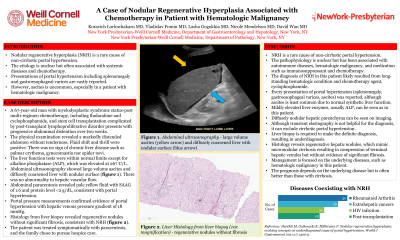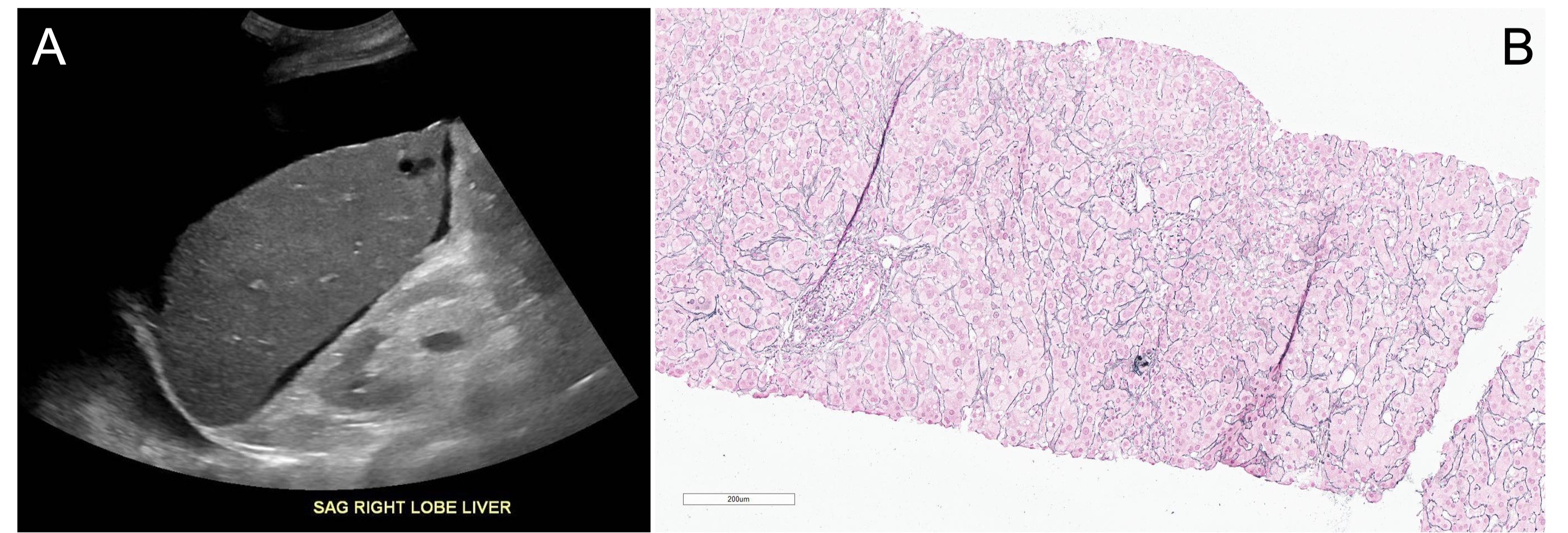Tuesday Poster Session
Category: Liver
P3991 - A Case of Nodular Regenerative Hyperplasia Associated With Chemotherapy in Patient With Hematologic Malignancy
Tuesday, October 24, 2023
10:30 AM - 4:00 PM PT
Location: Exhibit Hall

Has Audio

Koravich Lorlowhakarn, MD
King Chulalongkorn Memorial Hospital
Bangkok, Krung Thep, Thailand
Presenting Author(s)
Koravich Lorlowhakarn, MD1, Vladislav Fomin, MD2, Lasha Gogokhia, MD3, Nicole Mendelson, MD4, David Wan, BS, MD5
1King Chulalongkorn Memorial Hospital, Bangkok, Krung Thep, Thailand; 2New York-Presbyterian Hospital/Weill Cornell Medical College, New York, NY; 3New York-Presbyterian Hospital/Weill Cornell Medical Center, New York, NY; 4Weill Cornell Medicine/New York Presbyterian, New York, NY; 5Weill Cornell Medicine, New York, NY
Introduction: Nodular regenerative hyperplasia (NRH) is a rare cause of non-cirrhotic portal hypertension. The etiology is unclear but often related to systemic diseases and chemotherapy. Presentations including splenomegaly and varices are vastly reported. However, ascites is uncommon, especially in a patient with hematologic malignancy.
Case Description/Methods: A 67-year-old patient with myelodysplastic syndrome status-post multi-regimen chemotherapy, including fludarabine and cyclophosphamide, and stem cell transplantation presents with abdominal distention over two weeks. The physical examination revealed a distended abdomen without tenderness. The liver function tests were within normal limits except for ALP, which was elevated at 267 U/L. Abdominal ultrasonography showed large volume ascites and diffusely coarsened liver with nodular surface (figure A). There was no abnormal hepatic vascular flow. Abdominal paracentesis revealed pale yellow fluid with SAAG of 1.6 and protein < 2 g/dL. Portal pressure measurements confirmed portal hypertension with hepatic venous pressure gradient of 18 mmHg. Histology from liver biopsy revealed regenerative nodules without significant fibrosis, consistent with NRH (figure B). The patient was treated symptomatically with paracentesis, and the family chose to pursue hospice care.
Discussion: NRH is a rare cause of non-cirrhotic portal hypertension. The pathophysiology is unclear but several cases have been associated with hematologic malignancy, and medication such as immunosuppressant and chemotherapy. The diagnosis of NRH in this patient likely resulted from long-standing hematologic condition and chemotherapy agent, cyclophosphamide. Every presentation of portal hypertension (splenomegaly, gastroesophageal varices, ascites) was reported, although ascites is least common due to normal synthetic liver function. Mildly elevated liver enzymes, usually ALP, can be seen as in this patient. Diffusely nodular hepatic parenchyma can be seen on imaging. Although transient elastography is not helpful for the diagnosis, it can exclude cirrhotic portal hypertension. Liver biopsy is required to make the diagnosis, resulting in underdiagnosis. Histology reveals regenerative hepatic nodules which mimic micronodular cirrhosis resulting in compression of terminal hepatic venules but without evidence of significant fibrosis. Management is focused on the underlying diseases such as hematologic malignancy in this patient. The prognosis varies but is often better than those with cirrhosis.

Disclosures:
Koravich Lorlowhakarn, MD1, Vladislav Fomin, MD2, Lasha Gogokhia, MD3, Nicole Mendelson, MD4, David Wan, BS, MD5. P3991 - A Case of Nodular Regenerative Hyperplasia Associated With Chemotherapy in Patient With Hematologic Malignancy, ACG 2023 Annual Scientific Meeting Abstracts. Vancouver, BC, Canada: American College of Gastroenterology.
1King Chulalongkorn Memorial Hospital, Bangkok, Krung Thep, Thailand; 2New York-Presbyterian Hospital/Weill Cornell Medical College, New York, NY; 3New York-Presbyterian Hospital/Weill Cornell Medical Center, New York, NY; 4Weill Cornell Medicine/New York Presbyterian, New York, NY; 5Weill Cornell Medicine, New York, NY
Introduction: Nodular regenerative hyperplasia (NRH) is a rare cause of non-cirrhotic portal hypertension. The etiology is unclear but often related to systemic diseases and chemotherapy. Presentations including splenomegaly and varices are vastly reported. However, ascites is uncommon, especially in a patient with hematologic malignancy.
Case Description/Methods: A 67-year-old patient with myelodysplastic syndrome status-post multi-regimen chemotherapy, including fludarabine and cyclophosphamide, and stem cell transplantation presents with abdominal distention over two weeks. The physical examination revealed a distended abdomen without tenderness. The liver function tests were within normal limits except for ALP, which was elevated at 267 U/L. Abdominal ultrasonography showed large volume ascites and diffusely coarsened liver with nodular surface (figure A). There was no abnormal hepatic vascular flow. Abdominal paracentesis revealed pale yellow fluid with SAAG of 1.6 and protein < 2 g/dL. Portal pressure measurements confirmed portal hypertension with hepatic venous pressure gradient of 18 mmHg. Histology from liver biopsy revealed regenerative nodules without significant fibrosis, consistent with NRH (figure B). The patient was treated symptomatically with paracentesis, and the family chose to pursue hospice care.
Discussion: NRH is a rare cause of non-cirrhotic portal hypertension. The pathophysiology is unclear but several cases have been associated with hematologic malignancy, and medication such as immunosuppressant and chemotherapy. The diagnosis of NRH in this patient likely resulted from long-standing hematologic condition and chemotherapy agent, cyclophosphamide. Every presentation of portal hypertension (splenomegaly, gastroesophageal varices, ascites) was reported, although ascites is least common due to normal synthetic liver function. Mildly elevated liver enzymes, usually ALP, can be seen as in this patient. Diffusely nodular hepatic parenchyma can be seen on imaging. Although transient elastography is not helpful for the diagnosis, it can exclude cirrhotic portal hypertension. Liver biopsy is required to make the diagnosis, resulting in underdiagnosis. Histology reveals regenerative hepatic nodules which mimic micronodular cirrhosis resulting in compression of terminal hepatic venules but without evidence of significant fibrosis. Management is focused on the underlying diseases such as hematologic malignancy in this patient. The prognosis varies but is often better than those with cirrhosis.

Figure: Figure A. Abdominal ultrasonography - large volume ascites and diffusely coarsened liver with nodular surface,
Figure B. Liver Histology (10x magnification) - regenerative nodules without fibrosis
Figure B. Liver Histology (10x magnification) - regenerative nodules without fibrosis
Disclosures:
Koravich Lorlowhakarn indicated no relevant financial relationships.
Vladislav Fomin indicated no relevant financial relationships.
Lasha Gogokhia indicated no relevant financial relationships.
Nicole Mendelson indicated no relevant financial relationships.
David Wan indicated no relevant financial relationships.
Koravich Lorlowhakarn, MD1, Vladislav Fomin, MD2, Lasha Gogokhia, MD3, Nicole Mendelson, MD4, David Wan, BS, MD5. P3991 - A Case of Nodular Regenerative Hyperplasia Associated With Chemotherapy in Patient With Hematologic Malignancy, ACG 2023 Annual Scientific Meeting Abstracts. Vancouver, BC, Canada: American College of Gastroenterology.
